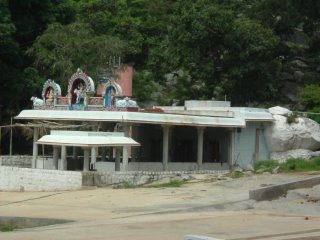Outing to Devara Betta (Thevar Betta) in neighbouring Tamil Nadu
Sunday dawned bright and crisp and was I raring to go.
The destination was towards Tamil Nadu and the plan to visit Devara Betta and Navadarshanam an ecofriendly farm community whose members are living as per natures ways.
Starting off early in the morning at 5.30 am I was lucky to get out of the city before the morning picnickers and others started their journeys. Hosur notoriously famous for traffic jams and unruly driving was strangely empty and the smooth flow of traffic with cool breeze hitting my face I made good progress.
Soon I was at Chandapura circle where I turned right and sped on towards Ankal. Unlike Bangalore city, here I could see rural folk fully active, farmers taking their bulls to the fields, some already at work in the fields, women drawing water from wells, some carrying sack loads on their heads and walking towards the bus stop, perhaps to take produce to the city market to sell.
Anekal was a little chaotic because of the election happening, there was all parties trying to put up stalls to canvass for votes right on the main road. Luckily I moved out of the city quickly and soon was on the Thali road heading towards Devara Betta. From Anekal it is only 7 km to Gummalapuram which is on the other side of the border. From Gummalapuram one has to travel further about 20 km on Thali road to reach Gopasandra and turn right there for Devara Betta.
Soon after crossing Ankeal the road becomes quite bad, and potholed. But after Gummalapuram there is no road at all, there is only a semblance that there might have been an asphalted road sometime in the distant past. But anyway the scenery flanking the road is well worth the bumpy ride. Lush green fields, far hillocks, punctuated by quaint temples take away the road fatigue.
Before reaching Gopasandra, I stopped at a small viragal (Herostone) temple and to my surprise found two more damaged herostones in the fields close by. Though the herostones are attractively carved they are neglected and most of them are lieing here and there without any attention being paid to them.
One thing is surprising, everyone here speaks fluent Kannada without even a hit of Tamil accent in their voices. And like all villagers in India, they are highly helpful and provide good directions. At Shamanatham village one of the villagers informed me that the road to Devara Betta from Gopasandra was a completely tar road. Expecting a smooth road I rode on but that was not to be, the road from Gopasandra to Devarabetta must have been tarred some 20 years ago and today it is falling to bits. Only potholes and jelly stones greeted my tyres and suspension.
But the panoramic view of the distant twin-rocky hills crowned by temple kept me going. After a 30-minute, (7 km) ride I reached the base of Devara betta and was dismayed to find that the temple mafia had already established base here also. But fortuntely being sited at the edge of the Thally reserved forest, not much damage has been done to the greenery and environment except building of several concrete structures which successfully obstruct the view of the hills.
There is a large modern temple complex, two rainwater harvesting tanks and several modern buildings in the valley between two tall rocky cliffs. The left one is Devara betta crowned by the Shiva temple. There are no steps and one has to scramble up to the top by the easiest way suitable for him. The climb is well worth the effort as the top of the hill offers fantastic view of the Thally reserve forest. The quaint temple atop is open only on saturdays and festive occasions. Otherwise devotees just pay obeisance to the lord through the grill door, rest a while and head back.
Due to some strange belief villagers who come here lay a cairn of stones and return back. Cairn is a small construction made of rough stones laid one above the other. It is believed that if one seeks any specific desire to be fulfilled he/ she has to place a cairn atop here and it will be fulfilled. Looking at the number of cairns I am sure God has a tough task ahead fulfilling the desires of so many people.
From Thevar Betta I retraced my journey till Gummalapuram and turned left to visit Navadarshanam farm. Navadarshanam (‘new vision’) ashram is the brainchild of a few people who dared to defy the stringent demands laid down by a consumerist world. This is a place where a group of people have chosen to live one with nature, learning the lessons it has to offer and sharing their experiences with society. Fifteen years ago this 110-acre piece of land had fallen prey to man’s deforestation spree and desertified. But today Today, the land is home to over 100,000 trees, which play host to a variety of species of birds.
The farm generates its own electricity through solar, wind and other energy sources. They grow their own food and water is from the borewell.
“Nature has its own ways of healing. We din't plant a single tree in this land. All we did was to stop grazing and rest was done by nature,” says Ananthu, a post-graduate in systems design from Stanford University, who, with a group of like minded people, started Navadarshanam - an offshoot of a study circle in Delhi many years ago and to put the Gandhian thought and ideals started this farm.
It was a wonderful experience interacting with Ananthu and going around the farm. According to Ananthu, they have only fenced off 25 percent of the total land area and remaining part is left for nature to heal itself. This has resulted in excellent growth of greenery and trees and several herds of Deer, wild boar and other animals have already made this green acres their homes.
My aim is to do something similar, I hope I will be able to achieve it in future.















